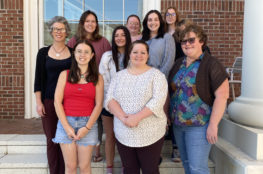Tomorrow, CCU students will join people around the country for a virtual transcription jam. “Transcription jam” is a disorienting word, though – what is it? A party? Does it involve music? Is it a gelatinous condiment? Will there be toast?
Let’s start with “transcription.” It means taking a document that exists in a .pdf form and retyping it so it’s in .html format. Once a document is in .html, then people around the world can search for it and find it with a database search. Researchers do transcriptions of historical documents, created originally in what is basically a snapshot, to make the documents accessible to more people. So, doing transcription essentially makes you a researcher, which is pretty cool.
Now, for the other word: “jam.” This word has been adopted as an alternative to the suffix “-athon.” We all know that suffix from words like “marathon,” “danceathon,” and “telethon” – it’s an event that brings a lot of people together for a specific purpose, usually with a fundraising component, in an event that lasts for an extended period of time, like several hours. Transcription-a-thon events might focus on documents related to a historic event, period, or person. The problem with the “a-thon” suffix, said transcription jam organizer Dr. Sarah Laiola, who is assistant professor of digital culture and design in the CCU Department of English, is that many events dubbed “-athon” suggests participants will be able to continue to do an action for a long period of time. For this event, all that is needed is your own laptop to be able to type on to transcribe the scanned documents. It doesn’t have to take very long, and there’s no physical stamina needed. The alternative name “jam” diminishes the ableist connotation to allow for anyone to join in and participate.
So that covers what the event is. Why do it, and why now? Douglass Day was founded by Mary Church Terrell, and the first transcription jam was hosted using her letters. In 2017 the Colored Conventions Project started reviving this specific Black history celebration by digitizing the archives used for the transcriptions. Each year, the Douglass Day Foundation selects one historic figure of focus. This year, we celebrate Mary Shadd Cary by transcribing documents from her archives. The original documents, and their scanned copies, are perceived as pictures, which preserved the words but denounced the emotional ties linked to the original, handwritten pieces. Holding the transcription jam allows for participants to become one with the words and the author and more attuned with the historical ties. Humanizing the living history into a more modern application creates the ability to properly preserve the evidence of that of Frederick Douglass, making these documents more real in the sense that once the transcription is finally complete, the digitized versions can remain intact forever.
So if the cupcakes and pizza aren’t enough to entice you to attend tomorrow’s event, head over to the transcription jam so you can be a maker of living Black American history.


